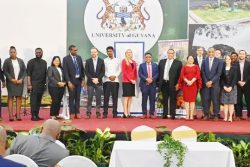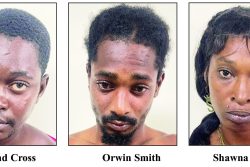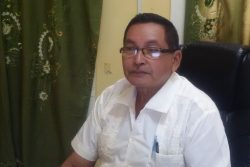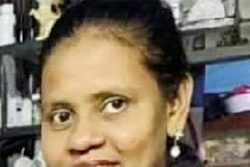We have a habit of describing Guyana as multicultural – which it is. However, in the nineteenth and early twentieth centuries it was even more so, as well as being polyglot. The magistrates’ courts at one point or another, had to be able to call upon a whole range of translators, covering various Indian languages, Chinese and Portuguese, plus those of any number of incidental immigrants.
But then what is now Guyana had always been a polyglot territory. In Dutch times there was the official language of Dutch which was used for formal communication, and then the lingua francas of Essequibo and Berbice, which were Dutch Creoles. These were known as Skepi Dutch and Berbice Dutch, and are believed to have been not very mutually intelligible. The soldiers hired by the company which owned Berbice, for example, were mostly of French and German extraction, although one presumes in their case they had a working knowledge of Berbice Dutch, if not standard Dutch.
And then, of course, as is the case today there were the various Indigenous languages. Mem-bers of some of the nations who came into regular contact with the Dutch could speak Skepi or Berbice Dutch, as the case may be; however, in most instances the governors had to communicate with them through interpreters. There was always a smattering of planters who could manage one or another Indigenous language, but more often than not the translators were African. Governor Van Hoogenheim of Berbice, for example, asked Africans on one occasion to translate what the Arawaks were saying to him, but eventually became suspicious that those particular interpreters were not rendering an honest translation.
In the seventeenth and early eighteenth centuries when trade with the interior nations was so important to the Dutch, the Essequibo colonial authorities would send out African traders into the hinterland to bargain for a whole range of products, but particularly annatto which was used to colour Dutch cheeses. This task clearly fell to those with a linguistic ability, and may have been passed down the generations. It is not clear whether all the Africans involved were free, or whether some were enslaved. In any event, it was a labour not occasionally without its dangers, since one African trader was killed on the job. By and large, however, it carried no risk of that kind, and one trader (presumably free) even married the daughter of a Carib captain.
This month is Indigenous Heritage Month when we celebrate the culture and contributions of the first peoples to come here. Nowadays there are nine of them – Arawaks, Wapishanas, Caribs, Makushis, Akawaios, Patamonas, Arecunas, Wai-Wais and Warraus. The first two speak languages (Arawakan) which are related, although not mutually intelligible; the next six are Cariban speakers, although only the Akawaios and Patamonas can understand one another; and the last, the Warraus, do not speak a language related to any other on this continent.
However, even in the case of the Indigenous population, people have come and gone here. To give a few examples, there were the Iaos who lived near Moruca, and were chased out by the Arawaks in the early seventeenth century. Then there were the Paravihanas who were domiciled here, but were chased up the Essequibo and into the Rio Branco by the Caribs in the eighteenth. The Chaimas, however, were new arrivals in the eighteenth century and settled near the Dutch Post in Moruca. They had originated from Spanish territory having fled efforts from the neighbouring authorities to place them in missions by force. The Spanish Governor wrote the Dutch Postholder (the man in charge of the post) demanding that he return them, but he refused, saying that it was his duty to protect the Amerindians.
It is not known what happened to this group of Chaimas, but perhaps they were absorbed by the local Arawaks. In any event, in 1817 there was a further influx into the Moruca area, particularly Santa Rosa, during the Venezuelan War of Independence, which arguably might have involved Chaimas at some level. The group which took refuge here had been driven out of their Capuchin missions in Venezuela and its members killed when found.
There has never been any great certainty about which nations were involved, since the Spanish missions tended to hold mixed populations of Indigenous people; however, at least one authority believes that many were Chaimas. Be that as it may, they settled among the surrounding Arawaks, which is how they came to be known as ‘Spanish Arawaks’. Members of the older generation were often tri-lingual, speaking Spanish, Arawak and English.
A more unfortunate story of arrival is that of the Tarumas, who came into the far south around the Kuyuwini, Kassikaityu area in the first quarter of the eighteenth century from their lands on the Rio Negro. Early last century they fell victim to a strange disease, which almost wiped out the entire population. There were a few survivors who were absorbed by the Wapishanas, but as a discrete nation they became extinct. There has been some suggestion – and it is only one possibility – that they were the last victims of the ʼflu epidemic which killed millions of people around the world after the First World War.
In the nineteenth century with the greater degree of European and coastal penetration into the interior, there were all kinds of demographic changes, not a few of them wrought by the introduction of new diseases. The Caribs, once the most numerous nation in what had been the colony of Essequibo, became one of our least prominent ones, numerically speaking. As the earlier distribution agents for Dutch goods in the hinterland, an activity connected eventually with their slave-trading activities, many of them may have moved out after the abolition of Amerindian slavery and the slave trade here. However, a lot more, particularly those on the Essequibo River proper, may have died out as a consequence of European disease.
Representatives of other groups came to Robert Schomburgk’s notice when he surveyed Guyana at the beginning of the 1840s, such as Amaripas, Maopityans, Piaoghottos and Drios, none of whom are here now.
And now we have Warraus taking refuge here from an anarchic Venezuela. Portions of the nation have always been here, and currently they can be found in the North-West and Orealla. In the nineteenth century they told the Rev Brett that the Caribs had chased them from here into the Orinoco delta, but clearly they followed the Dutch back into Guyana, since they could be found at the mouths of all the major rivers of this country thereafter. That they moved out from the main rivers downstream eventually as well may be a consequence of the fact that plantations were being laid out there as well as along the coast towards the end of the eighteenth century.
This has always been a nation of many peoples, many languages. The tragedy of our past aside, there is still much to learn about all those who came – and in some cases, left. Understanding comes first with knowledge.








